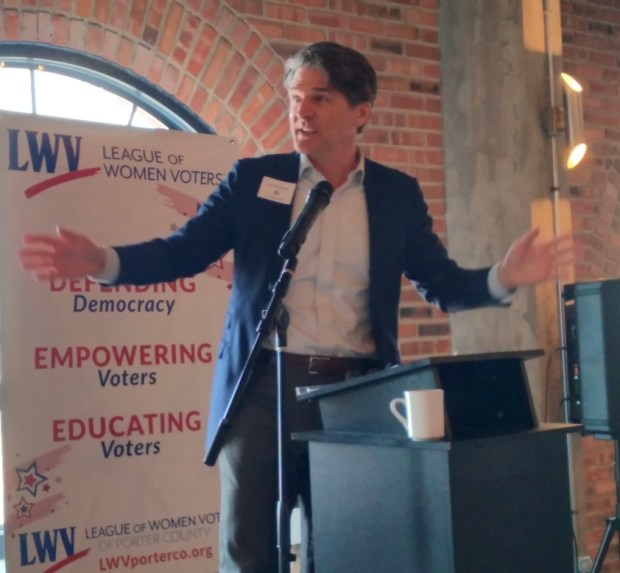There are concerns about how federal funding cuts might hamper environmental enforcement in the Great Lakes region, but state and local governments along with volunteer organizations in recent years have proven they are willing to step up on such issues.
That was the picture presented by Joel Brammeier, CEO of the Alliance for the Great Lakes, who was the keynote speaker for Sail Away into Lake Michigan’s Future held Thursday at the Indiana Dunes Pavilion. The League of Women Voters organizations from the Calumet Region, LaPorte County and Porter County co-sponsored the event.
It was a homecoming for Brammeier, who first visited the Indiana Dunes National and State Parks when he was a student at Valparaiso University. Brammeier, who lives in the Chicago area, renewed his acquaintance with the Dunes during the pandemic.
Brammeier leads the non-partisan organization with a team of professionals and a network of 15,000 volunteers dedicated to protecting clean water for the Great Lakes. He gave a balanced perspective of negative recent developments alongside positive strides that have been made in improving Lake Michigan’s water quality.
A major concern is the proposed 65% cut in federal Environmental Protection Agency funds, along with how a reorganization of regional branches of the agency will impact enforcement efforts.
“Environmental protection is absolutely not a duty or obligation our government can abandon,” Brammeier said.
Brammeier also noted that there needs to be a greater investment in ensuring safe drinking water from the Great Lakes. There are $200 billion worth of identified infrastructure needs that include replacing crumbling sewage systems that discharge inadequately treated waste and lead-contaminated water lines.
The good news is the federal government in 2021 allocated $50 billion toward addressing some of these issues, Brammeier said.
“That’s only a down payment on the challenge we have in front of us,” Brammeier said.
Invasive species that can potentially ruin the habitat of the Great Lakes are another issue. Brammeier said it is a good development that the federal government committed $1 billion toward building a barrier at the Des Plaines River in Joliet, Illinois, to prevent bighead carp and silver carp from entering Lake Michigan.
But there are concerns about whether the U.S. Army Corps of Engineers will receive sufficient support to see the project through to the end, Brammeier said.
While there are plenty of reasons to worry about the future, Brammeier emphasized how much the water quality in the Great Lakes has improved during the last 15 years.
The improvement can be traced to the Great Lakes Restoration Initiative that invested nearly $4 billion toward the cleanup of some of the worst contaminated shoreland. Brammeier noted there is bipartisan support for the restoration initiative.
“The fact is, the Great Lakes ecosystem is getting better. It has been getting better for the past 15 years,” Brammeier said.
The federal Clean Water Act of 1972 was the first big step toward better water quality for the Great Lakes.
“In Northwest Indiana, you can literally see evidence of that,” Brammeier said.
Another positive point Brammeier cited was how state and local governments have become more vigilant in pursuing environmental issues. He said the state and local governments may have to assume greater leadership in ensuring that environmental issues are addressed.
Brammeier noted that the state of Illinois is close to banning the use of poly Styrofoam products as an example. The state of Minnesota also passed a law that holds plastic producers accountable for polluting the waters.
Research shows that 22 million pounds of plastics enter the Great Lakes every year. The discarded plastics break down, with the particles entering drinking water, Brammeier said.
One issue that might have to be addressed by state and local governments is the high water usage required for hyperscale data centers.
Brammeier said data centers have become an issue in the Great Lakes. Several data centers are being built in Indiana, and developers seek to build more. Brammeier said the question is whether this is a good use of freshwater resources.
“Recognition of how we use water in the Great Lakes is often the last thing we do after all those other decisions have been made,” Brammeier said.
Brammeier said that he has seen how state and local governments, along with volunteer organizations, have become stronger and key in protecting the Great Lakes.
“We’re starting to see that if federal leadership backs away, they are going to find ways to step up and lead,” Brammeier said.
Victoria Wittig, the Urban Waters Partnership coordinator in Northwest Indiana, talked about the importance of collaboration with environmental groups and private funding sources to address environmental issues. She told the stories of how local groups have come together to make a difference.
“We’ve got a lot of strength in our region. We’ve got a lot of incredible talent. We’ve got a lot of incredible passion and a history that’s deeply rooted in fighting for our environment,” Wittig said.

Wittig pointed to successes, like the reclamation of abandoned land in Gary along the West Branch of the Little Calumet River. Organizations that included the Wetlands Initiative, Audubon Great Lakes, Lake County Parks and Recreation, Indiana University Northwest and NIPSCO came together on the project.
As a result, sandhill cranes have returned to raise their babies on the restored wetland.
With teamwork from groups like the Northwest Indiana Paddling Association and Save the Dunes, downed ash trees were removed from the East Branch of the Little Calumet River. The East Branch also has the distinction of having the most ADA accessible ramps for kayak users, Wittig said.
“The power of partnerships is unstoppable,” Wittig said. “Things we can do together is how we are going to thread the needle through the challenges we face.”
Jim Woods is a freelance reporter for the Post-Tribune.




